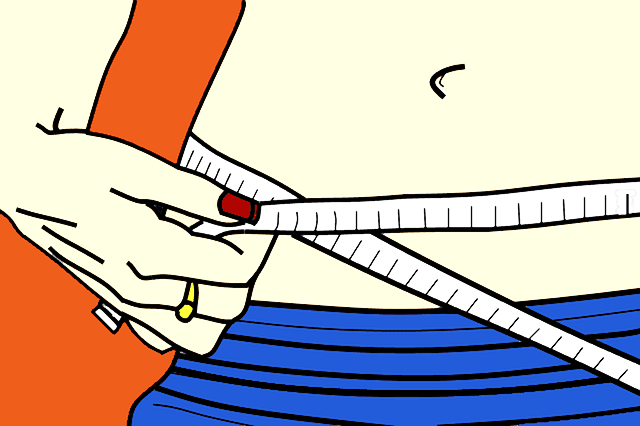Two Numbers That Are More Important Than Your BMI Score
If you’ve followed my content over the years, you know I’m not a fan of relying on a body mass index, or BMI score, to gauge your health. This is especially true if you are an active person who exercises regularly.
Why? Because a BMI score is a very simple calculation based on your height and weight. It completely ignores one of the most important factors for your health: your body composition.
It can’t tell the difference between a pound of muscle and a pound of fat. A 2025 study highlighted in the *European Scientist* confirmed that BMI score frequently misclassifies muscular athletes as overweight or even obese. In my years as a certified coach, I’ve seen this firsthand. A lean bodybuilder with a six-pack can easily be flagged as “obese” by the BMI chart, which shows how flawed this single number can be.
The truth is, two other numbers give you a much more accurate picture of your health and progress. Let’s focus on the metrics that truly matter.
Disclaimer: This article is for informational purposes only and is not meant to treat or diagnose any condition. It is recommended that you speak with your doctor before starting any exercise program, changing your daily nutrition, or adding any supplements to your regimen.
Table of contents
Key Takeaways
- The BMI score is often misleading because it doesn’t distinguish between muscle and fat, potentially misclassifying active individuals as overweight.
- Body fat percentage provides a more accurate view of health, with a crucial distinction between subcutaneous fat (under the skin) and visceral fat (around organs), which is more dangerous.
- Muscle mass percentage is vital for a healthy metabolism, as muscle burns more calories at rest than fat and helps protect against age-related physical decline.
- Accurate measurement methods range from clinical DEXA scans to accessible at-home tools like bioimpedance scales and skinfold calipers.
Focus on These 2 Numbers Rather Than Your BMI Score
Instead of getting fixated on your BMI score, it’s time to shift your attention to two numbers that paint a far more accurate and actionable picture of your health.
1. Body Fat Percentage
Your body fat percentage tells you how much of your total weight is actual fat tissue. It’s a direct measurement of your body composition. While you need some essential fat to protect organs and regulate hormones, carrying excess fat can significantly increase health risks.
It’s also important to understand that not all body fat is the same. There are two main types:
- Subcutaneous Fat: This is the “pinchable” fat that lies just under your skin. While cosmetically noticeable, it is generally considered less harmful than visceral fat.
- Visceral Fat: This fat is stored deep within your abdominal cavity, surrounding vital organs like your liver and intestines. High levels of visceral fat are strongly linked to serious health issues, including heart disease, type 2 diabetes, and high blood pressure, because it releases inflammatory substances.
The American Council on Exercise (ACE) provides widely accepted guidelines for body fat percentages, which offer a much better target than a generic weight goal or trying to hit a certain BMI score.
| Classification | Women (% Body Fat) | Men (% Body Fat) |
|---|---|---|
| Essential Fat | 10-13% | 2-5% |
| Athletes | 14-20% | 6-13% |
| Fitness | 21-24% | 14-17% |
| Average | 25-31% | 18-24% |
| Obese | 32%+ | 25%+ |
So, how can you measure this number? You have several options ranging from clinical-grade to convenient at-home tools.
Professional Measurement Methods
- DEXA Scan (Dual-Energy X-ray Absorptiometry): This is often considered the gold standard. A DEXA scan provides a detailed breakdown of your bone density, lean mass, and fat mass with high accuracy. You can typically find these at specialized clinics or universities.
- Hydrostatic Weighing (Underwater Weighing): This method calculates body density by measuring how much water you displace when submerged. It’s very accurate but less common today due to its complexity.
- Air Displacement Plethysmography (Bod Pod): Similar to underwater weighing, the Bod Pod uses air displacement to measure your body volume and density. It’s quick, non-invasive, and highly accurate.
At-Home Measurement Methods
For tracking progress at home, consistency is more important than perfect accuracy. These tools are great for monitoring trends.
Check out this BMI calculator!
- Bioelectrical Impedance Analysis (BIA) Scales: The scale or handheld device sends a harmless electrical current through your body. The speed of the current determines your body fat percentage. For best results, use it at the same time of day and under similar hydration levels each time, as factors like water and food intake can affect readings.
- Skinfold Calipers: This affordable tool measures the thickness of subcutaneous fat at several points on your body. While it requires a bit of practice, it can be quite accurate for tracking changes when done consistently.
2. Muscle Mass Percentage
The second number you should pay close attention rather than a BMI score is your muscle mass percentage. This metric tells you how much of your body weight consists of muscle. It’s a key indicator of your metabolic health.
Here’s why it’s so important: a pound of muscle burns more calories at rest than a pound of fat. Research from the University of New Mexico shows muscle tissue contributes about 20% to your daily energy expenditure, while fat only contributes 5%. This means the more muscle you have, the higher your resting metabolic rate will be, making weight management easier.
Unfortunately, we naturally lose muscle as we age, a process known as sarcopenia. Studies show that after age 30, you can lose 3-8% of your muscle mass per decade, and this rate accelerates after 60. This loss slows your metabolism and increases the risk of falls and frailty later in life.
The good news is you can fight back. Resistance training is the most effective way to build and maintain muscle mass, a process called hypertrophy. By challenging your muscles, you create tiny micro-tears that, when repaired, build back stronger and larger fibers.
To support this muscle growth, I always tell my clients to prioritize protein. The American College of Sports Medicine recommends that active adults consume between 1.2 to 2.0 grams of protein per kilogram of body weight daily to support muscle repair and growth.

BMI Score FAQs
What is a good muscle mass percentage?
While official guidelines are still developing, a 2000 study provides useful averages. For men ages 18-35, a healthy range is typically 40-44% of total body weight. For women in the same age group, it’s around 31-33%. These numbers tend to decrease with age.
Is waist-to-hip ratio another good alternative to BMI?
Yes, absolutely. The waist-to-hip ratio (WHR) is an excellent and simple tool for assessing health risk. It helps identify how much fat is stored around your abdomen. According to the World Health Organization, a WHR above 0.85 for women and 0.90 for men indicates a higher risk for conditions like heart disease.
How often should I measure my body fat and muscle mass?
For consistent tracking, measuring every 2-4 weeks is a great approach. This is frequent enough to see trends and make adjustments to your fitness and nutrition plan without getting discouraged by daily fluctuations, which are often caused by changes in water retention.


*Disclosure: This article may contain affiliate links or ads, which means we earn a small commission at no extra cost to you if you make a purchase through these links. These commissions help support the operation and maintenance of our website, allowing us to continue producing free valuable content. Your support is genuinely appreciated, whether you choose to use our links or not. Thank you for being a part of our community and enjoying our content.
PLEASE CONSIDER SHARING THIS ON YOUR SOCIAL MEDIA TO HELP OTHERS LEARN MORE ABOUT THIS TOPIC.





